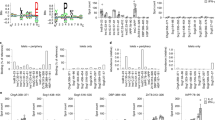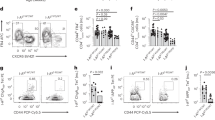Abstract
Type 1 diabetes is an autoimmune disease in which the insulin-producing pancreatic β cells are destroyed at an early age by an immune process that involves both CD4 and CD8 T lymphocytes. The identification of autoantigens in diabetes is very important for the design of antigen-specific immunotherapy. By screening a pancreatic islet cDNA library, we have identified the autoantigen recognized by highly pathogenic CD8 T cells in the non-obese diabetic mouse, one of the best animal models for human diabetes. This is the first identification, to our knowledge, of a CD8 T-cell epitope in an autoimmune disease. The peptide recognized by the cells is in the same region of the insulin B chain as the epitope recognized by previously isolated pathogenic CD4 T cells. This has very important implications for the potential use of insulin in preventative therapy.
This is a preview of subscription content, access via your institution
Access options
Subscribe to this journal
Receive 12 print issues and online access
$209.00 per year
only $17.42 per issue
Buy this article
- Purchase on Springer Link
- Instant access to full article PDF
Prices may be subject to local taxes which are calculated during checkout



Similar content being viewed by others
References
Serreze, D.V., Leiter, E.H., Christianson, G.J., Greiner, D. & Roopenian, D.C. Major histocompatibility complex class I-deficient NOD-B2mnull mice are diabetes and insulitis resistant. Diabetes 43, 505–509 ( 1994).
Wicker, L.S. et al. Beta 2-microglobulin-deficient NOD mice do not develop insulitis or diabetes. Diabetes 43, 500– 504 (1994).
Wang, B., Gonzalez, A., Benoist, C. & Mathis, D. The role of CD8+ T cells in the initiation of insulin-dependent diabetes mellitus. Eur. J. Immunol. 26, 1762– 1769 (1996).
Serreze, D.V. et al. Initiation of autoimmune diabetes in NOD/Lt mice is MHC class I-dependent. J. Immunol. 158, 3978– 3986 (1997).
Kay, T.W., Parker, J.L., Stephens, L.A., Thomas, H.E. & Allison, J. RIP-beta 2-microglobulin transgene expression restores insulitis, but not diabetes, in beta 2-microglobulin null nonobese diabetic mice. J. Immunol. 157, 3688–3693 (1996).
Wong, F.S., Visintin, I., Wen, L., Flavell, R.A. & Janeway, C.J. CD8 T cell clones from young nonobese diabetic (NOD) islets can transfer rapid onset of diabetes in NOD mice in the absence of CD4 cells. J. Exp. Med. 183, 67– 76 (1996).
Nagata, M., Santamaria, P., Kawamura, T., Utsugi, T. & Yoon, J.W. Evidence for the role of CD8+ cytotoxic T cells in the destruction of pancreatic beta-cells in nonobese diabetic mice. J. Immunol. 152, 2042– 2050 (1994).
Shimizu, J., Kanagawa, O. & Unanue, E.R. Presentation of beta-cell antigens to CD4+ and CD8+ T cells of non- obese diabetic mice. J. Immunol. 151 , 1723–1730 (1993).
Palmer, J.P. et al. Insulin antibodies in insulin-dependent diabetics before insulin treatment. Science 222, 1337– 1339 (1983).
Baekkeskov, S. et al. Identification of the 64K autoantigen in insulin-dependent diabetes as the GABA-synthesizing enzyme glutamic acid decarboxylase. Nature 347, 151–156 ( 1990); erratum: 347, 782 (1990).
Solimena, M. et al. ICA 512, an autoantigen of type I diabetes, is an intrinsic membrane protein of neurosecretory granules. Embo. J. 15, 2102–2114 (1996).
Bergman, B. & Haskins, K. Islet-specific T-cell clones from the NOD mouse respond to beta-granule antigen. Diabetes 43, 197–203 (1994).
Daniel, D. & Wegmann, D.R. Protection of nonobese diabetic mice from diabetes by intranasal or subcutaneous administration of insulin peptide B-(9-23). Proc. Natl. Acad. Sci. USA 93, 956–960 (1996).
Zekzer, D. et al. GAD-reactive CD4+ Th1 cells induce diabetes in NOD/SCID mice. J. Clin. Invest. 101, 68– 73 (1998).
Elias, D., Markovits, D., Reshef, T., van der Zee, R. & Cohen, I.R. Induction and therapy of autoimmune diabetes in the non-obese diabetic (NOD/Lt) mouse by a 65-kDa heat shock protein. Proc. Natl. Acad. Sci. USA 87, 1576– 1580 (1990).
Karttunen, J., Sanderson, S. & Shastri, N. Detection of rare antigen-presenting cells by the lacZ T-cell activation assay suggests an expression cloning strategy for T-cell antigens. Proc. Natl. Acad. Sci. USA 89, 6020–6024 (1992).
Sanderson, S. & Shastri, N. LacZ inducible, antigen/MHC-specific T cell hybrids. Int. Immunol. 6, 369– 376 (1994).
Malarkannan, S., Gonzalez, F., Nguyen, V., Adair, G. & Shastri, N. Alloreactive CD8+ T cells can recognize unusual, rare, and unique processed peptide/MHC complexes. J. Immunol. 157, 4464–4473 (1996).
Sanderson, S., Campbell, D.J. & Shastri, N. Identification of a CD4+ T cell-stimulating antigen of pathogenic bacteria by expression cloning. J. Exp. Med. 182, 1751–1757 (1995).
Malarkannan, S., Serwold, T., Nguyen, V., Sherman, L.A. & Shastri, N. The mouse mammary tumor virus env gene is the source of a CD8+ T-cell- stimulating peptide presented by a major histocompatibility complex class I molecule in a murine thymoma. Proc. Natl. Acad. Sci. USA 93, 13991–13996 (1996).
Wentworth, B.M., Schaefer, I.M., Villa-Komaroff, L. & Chirgwin, J.M. Characterization of the two nonallelic genes encoding mouse preproinsulin. J. Mol. Evol. 23, 305– 312 (1986).
Busch, D.H., Pilip, I.M., Vijh, S. & Pamer, E.G. Coordinate regulation of complex T cell populations responding to bacterial infection. Immunity 8, 353–362 ( 1998).
Bergerot, I., Fabien, N., Maguer, V. & Thivolet, C. Oral administration of human insulin to NOD mice generates CD4+ T cells that suppress adoptive transfer of diabetes. J. Autoimmun. 7, 655 –663 (1994).
Harrison, L.C., Dempsey-Collier, M., Kramer, D.R. & Takahashi, K. Aerosol insulin induces regulatory CD8 gamma delta T cells that prevent murine insulin-dependent diabetes. J. Exp. Med. 184, 2167–2174 (1996).
Hutchings, P. & Cooke, A. Protection from insulin dependent diabetes mellitus afforded by insulin antigens in incomplete Freund's adjuvant depends on route of administration. J. Autoimmun. 11 , 127–130 (1998).
French, M.B. et al. Transgenic expression of mouse proinsulin II prevents diabetes in nonobese diabetic mice. Diabetes 46, 34 –39 (1997); erratum: 46, 924 (1997).
Zekzer, D. et al. Inhibition of diabetes by an insulin-reactive CD4 T-cell clone in the nonobese diabetic mouse. Diabetes 46, 1124–1132 (1997).
Smith, K.M., Olson, D.C., Hirose, R. & Hanahan, D. Pancreatic gene expression in rare cells of thymic medulla: evidence for functional contribution to T cell tolerance. Int. Immunol. 9, 1355 –1365 (1997).
Pugliese, A. et al. The insulin gene is transcribed in the human thymus and transcription levels correlated with allelic variation at the INS VNTR-IDDM2 susceptibility locus for type 1 diabetes. Nature Genet. 15, 293–297 (1997).
Bennett, S.T. et al. Insulin VNTR allele-specific effect in type 1 diabetes depends on identity of untransmitted paternal allele. The IMDIAB Group. Nature Genet. 17, 350–352 (1997).
Santamaria, P. et al. Beta-cell-cytotoxic CD8+ T cells from nonobese diabetic mice use highly homologous T cell receptor alpha-chain CDR3 sequences. J. Immunol. 154, 2494–2503 (1995).
DiLorenzo, T.P. et al. Major histocompatibility complex class I-restricted T cells are required for all but the end stages of diabetes development in nonobese diabetic mice and use a prevalent T cell receptor alpha chain gene rearrangement. Proc. Natl. Acad. Sci. USA 95, 12538– 12543 (1998).
Keller, R.J., Eisenbarth, G.S. & Jackson, R.A. Insulin prophylaxis in individuals at high risk of type I diabetes. Lancet 341, 927– 928 (1993).
The Diabetes Prevention Trial-Type 1 diabetes (DPT-1): implementation of screening and staging of relatives. DPT-1 Study Group. Transplant Proc. 27, 3377 ( 1995).
Carel, J.C. & Bougneres, P.F. Treatment of prediabetic patients with insulin: experience and future. European Prediabetes Study Group. Horm. Res. 45, 44–47 ( 1996).
Acknowledgements
We thank M. Altieri for islet isolation for preparation of the cDNA library and J. Rife and M. Tang for technical assistance. We also thank C. Viret, R. Medzhitov, P. Cresswell and R. Sherwin for discussions. DNA sequencing and peptide synthesis was done by the W.M. Keck Biotechnology facility of Yale University School of Medicine. This work was supported by Project 1 and the NOD and mutant mouse core B and islet isolation core C of NIH/JDFI diabetes program project grant DK-53015. F.S.W. and L.W. are recipients of JDFI Career Development Awards. J.K. was a recipient of a Howard Hughes post-doctoral fellowship and C.D. was supported by a Student Research Fellowship from the American Heart Association. C.A.J.,Jr. is an investigator of the Howard Hughes Medical Institute.
Author information
Authors and Affiliations
Corresponding author
Rights and permissions
About this article
Cite this article
Wong, F., Karttunen, J., Dumont, C. et al. Identification of an MHC class I-restricted autoantigen in type 1 diabetes by screening an organ-specific cDNA library. Nat Med 5, 1026–1031 (1999). https://doi.org/10.1038/12465
Received:
Accepted:
Issue Date:
DOI: https://doi.org/10.1038/12465
This article is cited by
-
Autoimmune diseases: targets, biology, and drug discovery
Acta Pharmacologica Sinica (2024)
-
I-Ag7 β56/57 polymorphisms regulate non-cognate negative selection to CD4+ T cell orchestrators of type 1 diabetes
Nature Immunology (2023)
-
Toll-like receptor 7 deficiency suppresses type 1 diabetes development by modulating B-cell differentiation and function
Cellular & Molecular Immunology (2021)
-
Immunosuppression overcomes insulin- and vector-specific immune responses that limit efficacy of AAV2/8-mediated insulin gene therapy in NOD mice
Gene Therapy (2019)
-
Thymus-specific serine protease, a protease that shapes the CD4 T cell repertoire
Immunogenetics (2019)



